It was our annual village Fun Run, 7 kilometres along village roads and countryside. The first back, as ever was Finn Johnson. I believe his time was 23 minutes, 57 seconds. Also, as ever, I took a few snaps…more photos in my Facebook Gallery.
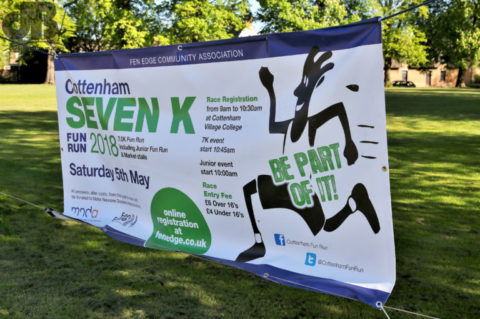

36.2055 years in science communication
News and views about photography, cameras, social media, as well as pointers to Dave Bradley’s photographic output. You can also find me on Imaging Storm, Instagram and Flickr as “sciencebase”
It was our annual village Fun Run, 7 kilometres along village roads and countryside. The first back, as ever was Finn Johnson. I believe his time was 23 minutes, 57 seconds. Also, as ever, I took a few snaps…more photos in my Facebook Gallery.


Some of you will know that Northumberland was famously a coal-mining region. My paternal grandfather, whose story I capture in my song “Coaldust and Seaspray” was a miner, just sayin’.
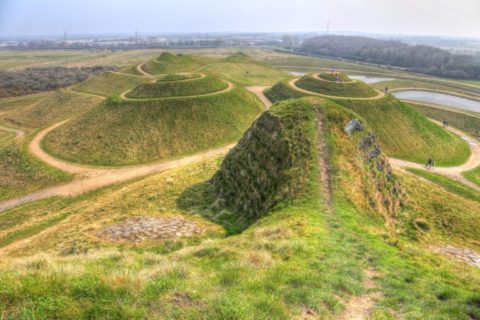
There were countless collieries and undersea mines as well as also open-cast mines. Surface mining near Cramlington was accompanied by art in the form of what is claimed to be the largest landform sculpture of the female form – Northumberlandia (the “Lady of the North” or “Slag Alice” to some).
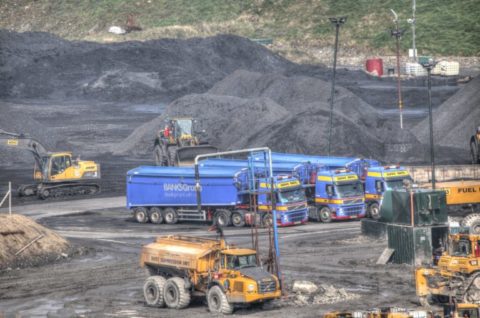
Northumberlandia was designed by American landscape architect Charles Jencks and was made from 1.5 million tonnes of earth from neighbouring Shotton Surface Mine on the Blagdon Estate owned by fellow science writer Matt Ridley. NB Most science writers don’t own estates other than the vehicular type and any that they live on tend to be (ex) council. Anyway…
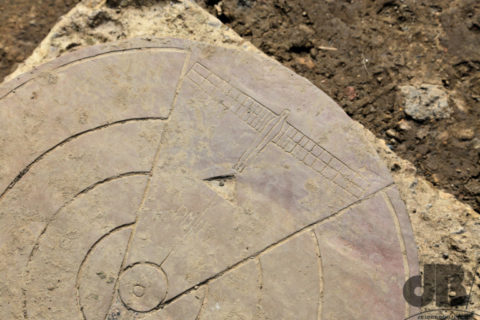
Shotton has operated on Blagdon almost continuously since 1943. The sculpture meanwhile is 34 metres high and 400 metres long, and set in 19 hectares of public park. Landscaping was undertaken in part by Cambridge Direct Tree Seeding (CDTS).
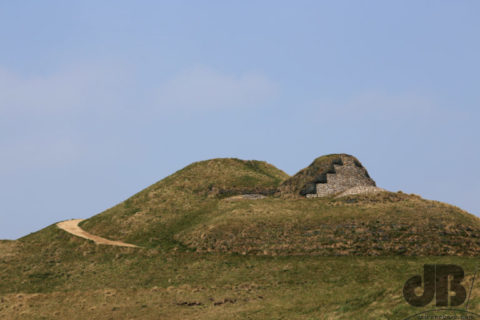
The neighbouring Shotton mine was granted government permissions to start mining in 2007 (despite opposition from the local council). It is still active, although it should have ceased operations in 2016. It provides 8% of UK coal output amounting to several million tonnes of coal.
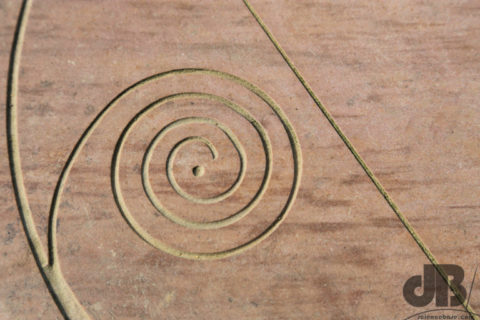
A Wildlife Trust representative at the Northumberlandia site told me that the company had been granted an extension but it would definitely close in 2018. The mine is continuously back-filled and ultimately will be landscaped and trees planted to make a much larger public park and nature reserve.
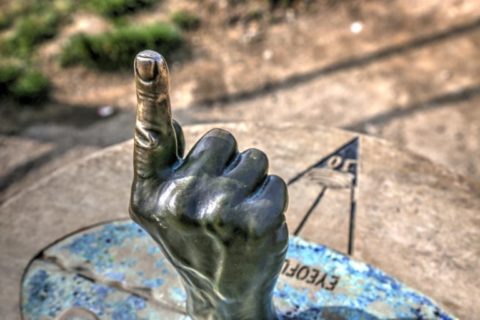
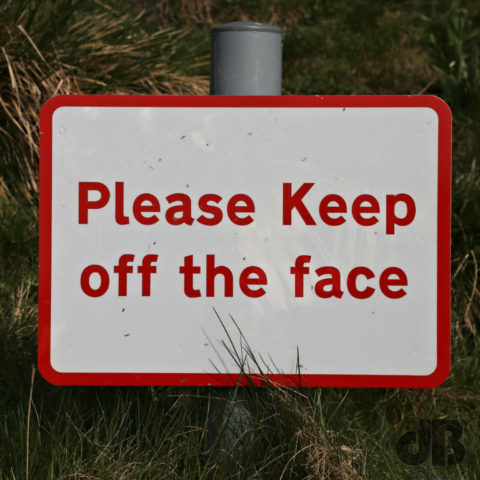
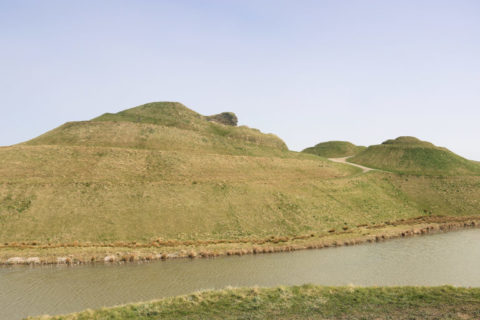
Having visited the bus stop opposite St Bartholomew’s Church in Long Benton near Newcastle to see the last remaining Waxwing (Bombycilla garrulus), we headed for the coast and dove straight into a heavy sea fret in what might one day be known as “Vera Land”, Seaton Sluice just north of Whitley Bay, Northumberland. Actually, I think they only filmed a bit of one episode here, maybe it could be George Gently Land instead.
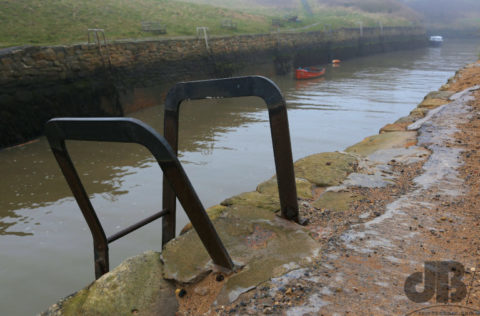
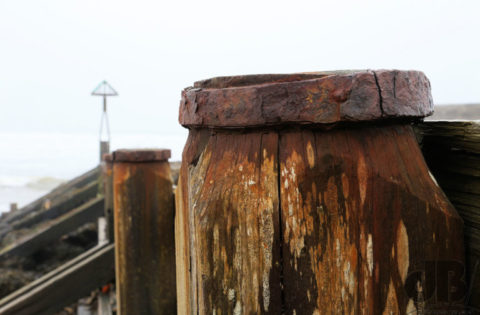
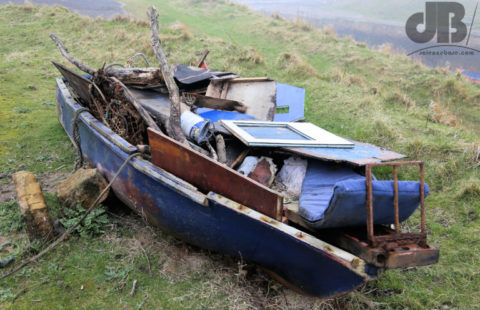
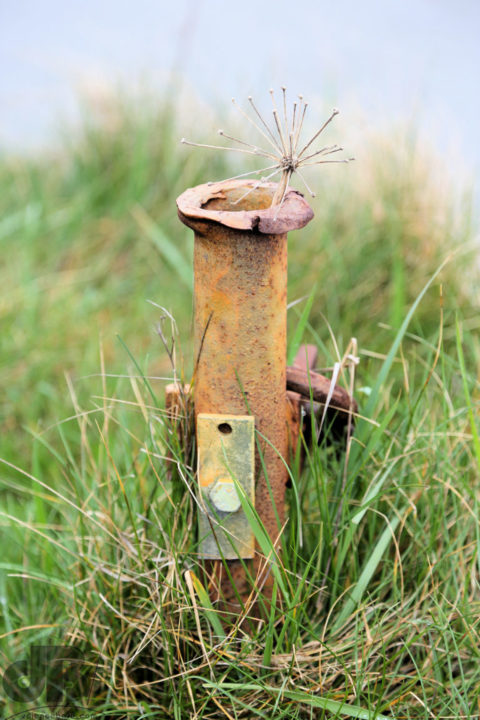
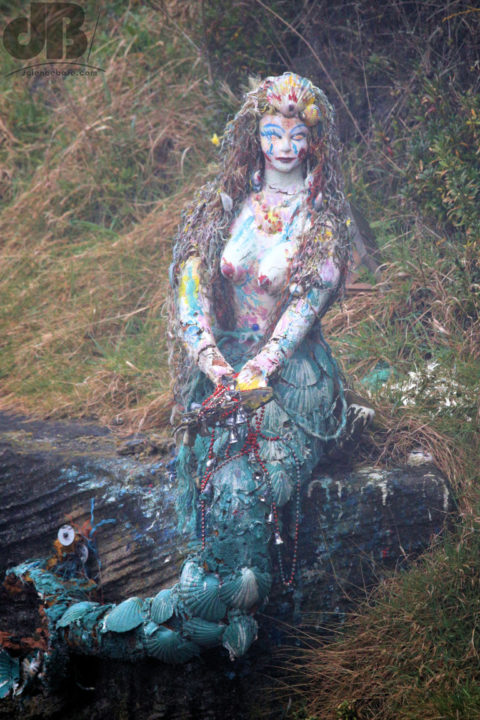
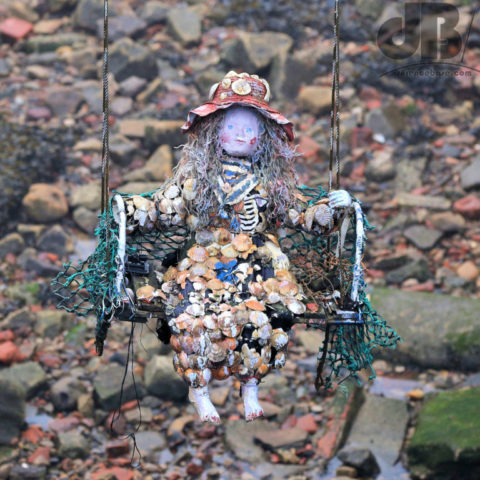
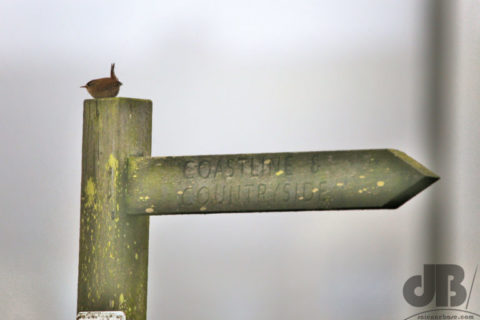
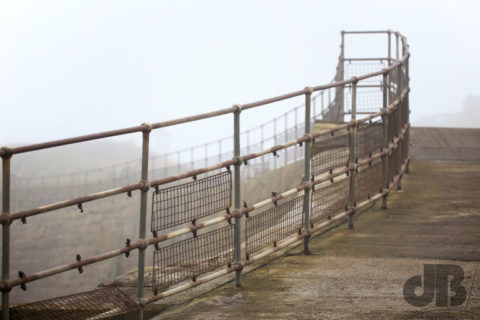
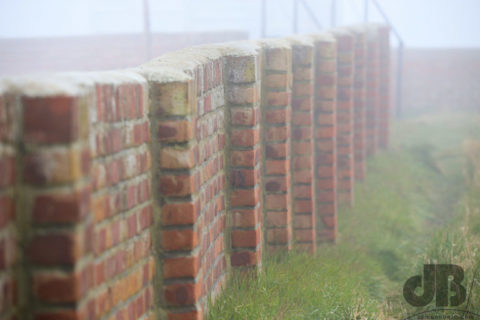
The Cambridgeshire village of Cottenham is famous for a lot of things – cheese, fires, the Pepys family, community activities, and, of course, being the source of the idiom “Hobson’s choice”. Hobson having stabled the horses for his Cambridge business at the foot of Lamb’s Lane, back in the day.
The village is also quite well known for its Anglo-Saxon or Mediaeval site, Crowlands Moat. The moat lies at the heart of the Broad Lane “birds” housing estate. The site was listed by English Heritage as a “scheduled ancient monument”. The moat originally surrounded the long-gone Crowlands Manor.
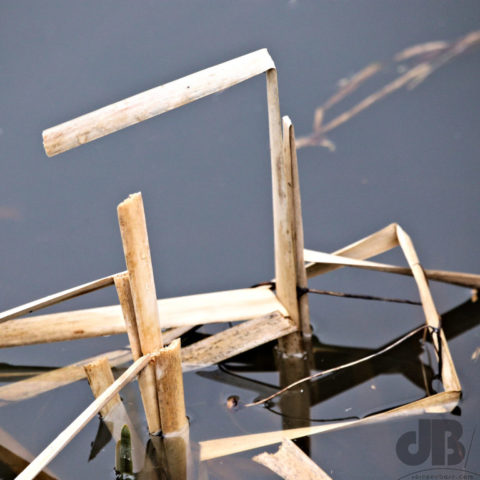
The moat is home to a significant breeding population of great crested newts (Triturus cristatus), a rare, and protected species. In the UK and across Europe it is generally illegal to kill, injure or take a northern crested newt, to possess or control any live or dead specimen or anything derived from them, to recklessly damage, destroy or obstruct access to any structure or place used for shelter or protection by the species, or to recklessly disturb its home or breeding grounds. The moat is also home to smooth newts (Lissotriton vulgaris).
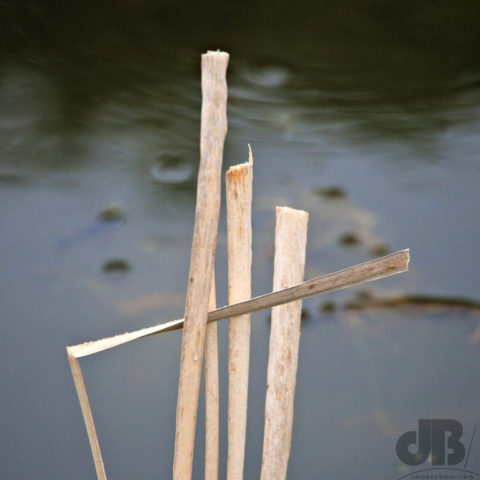
On a typically wet and grey Bank Holiday Monday we went looking for newts…and saw at most two, there were presumably many more lurking in the murky waters of the moat. Just the Common Newt though, no Great Cresteds…but they’re definitely there, according to my herpetologist friend who has monitored them.
Several people have asked about my photo on the cover of the January/February issue of the Cottenham Newsletter. They’re curious as to where I took the photo, how I got the church and the lode in the frame like that. A couple of people have even suggested that it must be a composite and have walked along the bank to see if they can see how I took it.
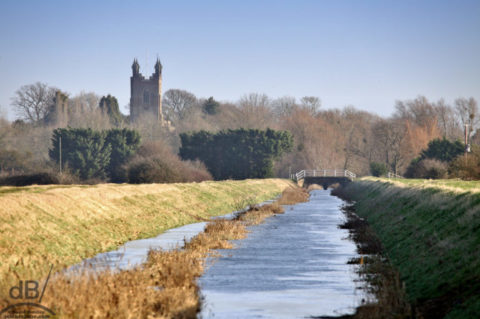
Well, it’s not a composite, there was no photographic trickery. It was snapped with a 600mm zoom lens on the 30th December 2017, just after 11am. I “developed” the photo in Paintshop Pro and cropped it to frame it nicely for the cover of the newsletter. The lode was almost full, which perhaps messes with one’s perspective. But, more than that zoom lenses notoriously compress the depth of an image, making the most distant object seem not only closer but also making it seem as if they’re the same sort of distance away as closer objects. It’s a useful effect and gives rise to intriguing and puzzling photos like this one.
Anyway, to settle any arguments, the photo was taken from the dog-leg in the Cottenham lode where the little wooden bridge emerges from Rampton Spinney. So, about 1.2 km from the Broad Lane Bridge (seen in the right of the photo) as the crow flies. All Saints Church (pictured in the left) would be about 2 km from that point.
Other technical details: Canon 6D, Sigma 150-600mm zoom, f/10, t 1/500s, ISO 1200.
UPDATE: March 2023 – I am currently using DxO PureRaw instead of the full PhotoLab. It does the same with denoising and lens/camera corrections. I then adjust curves and levels with PaintShopPro as I had been doing prior to trying PhotoLab.
UPDATE: January 2023 – I wrote this article back in 2018, since then various programs have come on to the market that offer AI approaches to denoising photographs many of which are much easier to use and work really well. For example, the Topaz AI Denoise tool reduces noise and blur and can even reduce motion blur, as I demonstrated in an article with a photograph of a Peregrine Falcon flying overhead. DxO Photolab is my current denoise software of choice though, its DeepPrime system effectively lowers the ISO of any noisy photograph by the equivalent of about three stops (like shooting at 400 rather than 3200 but with the same shutter speed and aperture). It lens/camera corrections built-in too as well as allowing you to adjust levels, curves, saturation etc etc.
Noise can be nice…look at that lovely grain in those classic monochrome prints, for instance. But, noise can be nasty, those purple speckles in that low-light holiday snap in that flashy bar with the expensive cocktails, for example. If only there were a way to get rid of the noise without losing any of the detail in the photo.
Now, I remember noise in spectroscopy at university, you could reduce it by cutting out any signal that was below a threshold. Unfortunately, as with photos that filtering cuts out detail and clarity. So, a solution was to run multiple spectra of the same sample, like taking the same photo, you could then stack them together so that the parts that are of interest add together. You then apply the filter to cull the dim parts, the noise. The bits that are the same in each shot (or spectrum will be added together, but the random noise will generally not overlap and so will not get stronger with the adding. The low-level filtering then applied will remove the noise and not cut the image. No more ambiguous spectral lines and no more purple speckles. That is in theory, at least. Your mileage in the laboratory or with your photos may vary.
De-noising by stacking together repeat frames of the same shot comes into its own when doing astrophotography where light levels are intrinsically low. Stack together a dozen photos of the Milky Way say, the stars and nebulae add together, then you can apply a cut to anything that isn’t as bright as the dimmest and you can reduce the noise significantly. Stack together a few hundred and your chances are even better, although you will have to use a system to move the camera as time goes on to avoid star trails.
Then it’s down to the software to work its tricks. One such tool called ImageMagick has been around for years and has a potentially daunting command-line interface for Windows, Mac, and Unix machines, but with its “evaluate-sequence” function it can nevertheless quickly process a whole stack of photos and reduce the noise in the output shot.
As a quick test, given it’s the middle of the afternoon here, I went to my office cupboard which is fairly dark even at midday, and searched out some dusty copies of an old book by the name of Deceived Wisdom, you may have heard of it. I piled up a few copies and with my camera on a tripod and the ISO turned as high as it will go to cut through the gloom, I snapped half a dozen close-ups of the spines of the books. The first photo shows one of the untouched photos, with a zoom in on a particularly noisy bit.
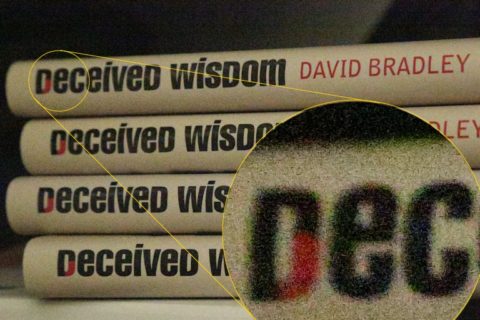
Next I downloaded the snaps, which all look essentially identical, but each having a slightly different random spray of noise. I then ran the following command in ImageMagick (there are other apps that will be more straightforward to work with having a GUI rather than relying on a command prompt. Nevertheless, within a minute or so the software has worked its magic(k).
magick convert *.jpg -evaluate-sequence median book-stack.jpg
And, so here’s the result, well the zoomed in area of the composite output photo, the average of the six essentially identical original frames with the noise filtered to a degree from the combined image. There is far less random colour fringing around the letters and overall it’s crisper. The next step would be to apply unsharp masking etc to work it up to a useful image.
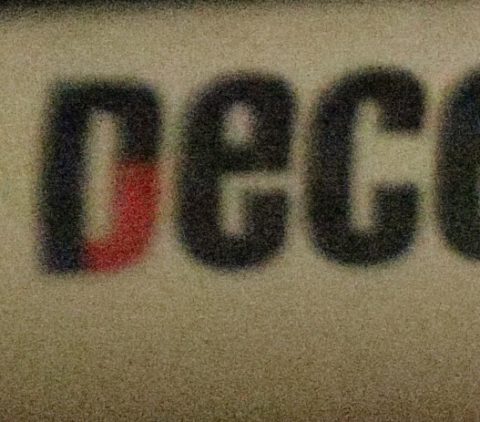
It’s not perfect, but there is far less noise than in any of the originals as you can hopefully see. The software you use can have fine adjustments, but perhaps the most important factor is taking more photos of the same thing. That’s probably not going to work at that holiday cocktail bar, but with patience should work nicely for astro shots. Of course, if I wanted a decent noise-free photo of my book, I could have taken them out of the cupboard piled them on my desk, lit them properly, used a flash and diffuser and what have you and got a really nice photo with a single frame. But, then what would you learn from me doing that other than that I still have copies of my old book?
I was given a nice 1:1 macro lens for Christmas (Tamron, 90mm f/2.8). It was giving excellent results out of the box, but having realised that my DSLR does allow one to tweak the autofocus micro adjustment in-camera. I thought I would calibrate it as I had with my 600mm Sigma zoom (albeit that was done off-camera with a USB adapter). There’s a much easier way to verify that your lens isn’t back focusing or front focusing with lenses of shorter focal length as you don’t have to be so far away from the calibration targeting; at least 50 times focal length, which for a 600mm lens is 30m but for a 90mm lens is just 4.5m. I also opted for the moire fringing method described here.
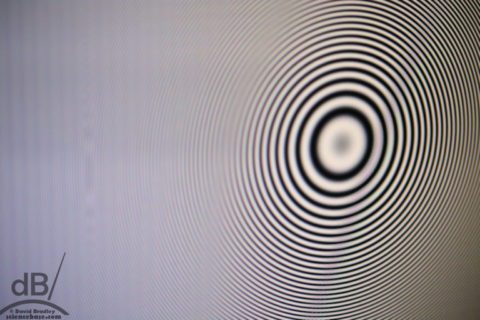
Basically, you set your camera on a tripod, manually focus in Live View on a pattern on your computer screen, then switch to autofocus in the viewfinder and watch how much and in which direction the focus ring moves to “focus”. Your camera may be front or back focusing and for most DSLRs above the prosumer level from Canon and Nikon you can micro adjust this to fix it and make the AF sharper. If I remember rightly, my DSLR will remember micro adjustment settings for 42 different lenses, which is an order of magnitude than I possess so plenty of data slots.
The bottom line is that if your camera allows you to, you should calibrate your lenses in-camera. There will almost always be tiny discrepancies between what the camera thinks the lens is focused on and what it is actually focused on forward or back. My 50mm prime lens needed a -2 adjustment, whereas the Tamron macro needed +10 (out of a range of -20 to +20). This was sufficient to bring the lenses up to snuff. With these adjustments, there is no focus ring movement from manual focus to autofocus. They’re calibrated.
It’s going to be harder to calibrate the big zoom lens as our garden is a lot less than 30m even across its diagonal and I also don’t fancy the chances of the camera nor a laptop with the moire pattern in this rain, so I’ll leave all that for another day.
Meanwhile, here’s another macro shot of the poinsettia cyathia, this time carried out with focus bracketing. It’s a useful technique, but I can see some artefacts where the leaves and/or camera moved ever so slightly between frames. Or, it’s just a side effect of the way Picolay works with a focus stack of images.
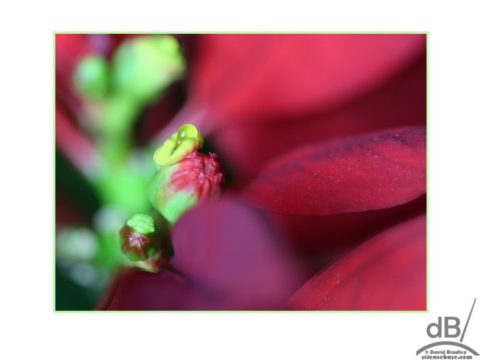
These micro-adjustments and calibration can make only a tiny and sometimes barely perceptible difference to sharpness at 100%, but useful if you’re going to enlarge or do a really tight crop. Of course, given the awful compression websites like Facebook apply when you upload to them, it might seem pointless. Indeed for some uploads, it’s probably fine to just apply an unsharp mask to areas of interest in a photo. But, given that the micro-adjustments are relatively easy to do, I’d say do them anyway.
UPDATE TO ANOTHER UPDATE: The Canon utility was hopeless, luckily I found a bit of open source software that takes back control much better and used it to focus stack yesterday morning’s moth and then combine the images, to much better effect.
ANOTHER UPDATE: It seems that the Canon EOS Utility should allow me to automate the process focus bracketing with my 6D…just installing and will test with tomorrow’s moth…assuming there’s another stunning species to photograph…may give it a miss if it’s just another Clouded Drab.
UPDATE: Been taking another look at this and applied focus stacking to my latest moth photo. There are several programs for focus stacking (Photoshop has it built in), Helicon Focus, Zerene Stacker, Picolay, and CombineZP (there are many others just search for focus stacking software). There’s also a tool for Canon dSLRs, DSLR Bracketeer, that lets you do the focus bracketing automatically and then you do the stacking in an app of your choice. There’s also a tool that lets you do the focusing on a bigger screen, like a tablet or computer, CamRanger, but you need a wireless tethering device. (Then there are camera rails!)
A narrow depth of field (DOF) has its pros and its cons in photography. Portraits often benefit from a nice sharp focus on the subject’s eye, but everything out of the plane of the face being out of focus so that backgrounds are blurred. In landscapes, the opposite is often required: foreground, middle ground and distance all needing to be nice and sharp (depending on your artistic wont, of course).
Fundamentally, DOF depends on the focal length of the lens, where you focus it and more importantly the f-stop you choose. The f-stop is the size of the aperture, essentially the hole that lets light into your camera. f-stop is given as a fractional ratio to the lens’ focal length of the maximum size it can be opened. So, f/2.8 is a big hole letting in lots of light (and needs to be balanced against a shorter shutter speed and/or lower ISO to get a properly exposed shot). Conversely, f/22 is a smaller hole and lets in far less light so requires a longer shutter speed (see my starburst article for diffraction effects possible with such an f-stop).
A larger aperture (smaller f-stop number, meaning a bigger fraction of the maximum size) means more light but a shorter DOF. This is part of the reason why things look blurry under water – there’s less light and so the pupils of your eyes open wider meaning a shorter DOF for your vision. Children who spend a lot of time swimming underwater without goggles can grow accustomed to the light levels and find that their pupils narrow and they can see sharper detail. I wrote about this effect among the Moken people for Discovery Channel back in the day.
Anyway, when you’re shooting close-ups of flowers and insects and such DOF becomes a real issue. With a 1:1 macro lens you are hoping to get the most detail possible but if the lens is within a few centimetres of the subject, then parts of the subject a few millimetres in front or behind your focus will not appear sharp. A top-notch lens with the possibility to shot with a slightly smaller aperture, provided there is sufficient light and without pushing the ISO to noisy high levels might get around the problem. But, there is another way.
You can focus stack your subject. Bracketing the point of focus from the closest to the farthest points on the object of your photographic desire. This is akin to creating genuine HDR (high dynamic range) photos where you expose for the dark, the mid-tones, and the highlights, stack the images together and create a composite that is neither under- nor over-exposed on any of those regions. Focus stacking brackets the focus and creates a composite.
There are plenty of HDR apps available, indeed some cameras and smartphones have an HDR mode that takes a series of photos very quickly one after the other with the bracketed exposures, stacks them together and erases the areas that are too dark or too bright, to give an even exposure. Works wonderfully in cathedrals when photographing the knave and altar and bright stained-glass windows in a single shot.
There are fewer “apps” for focus stacking, but there are some available (as discussed here). I found a piece of software called Picolay, which seems to do a nice job. It has lots of settings, but you can let it run on autopilot. You take a series of photos with the focus at different points on your subject (preferably done with a tripod and remote shutter to make them as near identically positioned in the frame as possible, focus aside).
You load the focus bracketed photos into the software and hit “go”. It calculates where the sharpest regions are in each photo, stacks them all together and essentially erases areas that are not sharp, giving you a composite that has an apparent DOF much greater than has any of the individual photos in the stack.
I plucked a crumpled leaf from our grapevine, set it up on a black plinth, put the camera on a tripod close to the leaf and moved the latter to frame it nicely. I then manually focused the macro lens on different areas of the leaf and snapped a dozen or so shots.
The shot below shows the software’s analysis of the stack of photos, I am assuming brighter colours meshes with sharper focus.
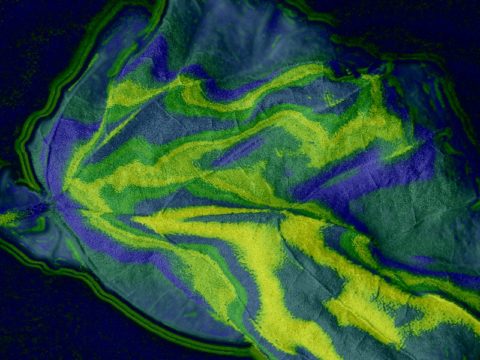
The following shot shows the processed stack, where much more of the leaf is in focus compared with any of the individual photos.
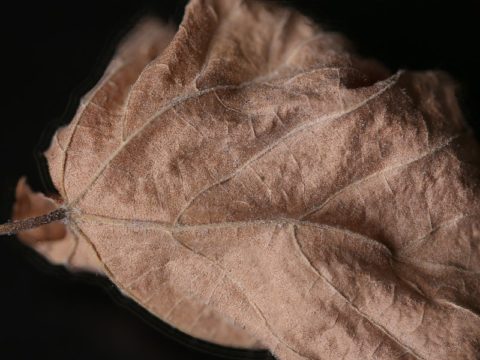
Here’s a photo of the leaf in which I’d focused on the upper portion of the frame rather than the main vein
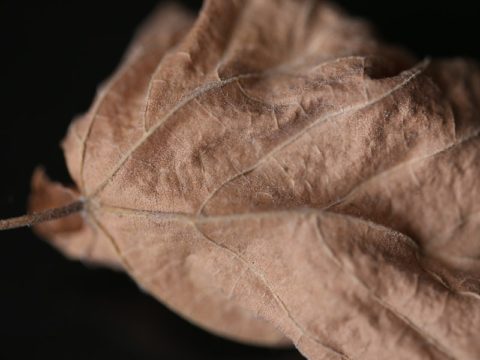
And, here’s one where the main vein is in focus, you will notice that neither of these shots is wholly sharp, whereas the stack above looks mostly crisp across the whole frame.
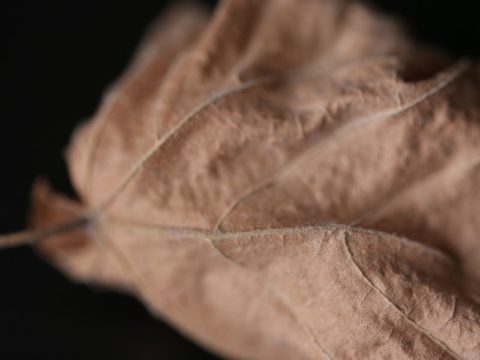
It’s not perfect and there are artefacts where the frames didn’t match perfectly. I did the experiment quite quickly. For a proper photo shoot, I’d spend more time setting things up just right and probably use a diffuse light source and maybe I ring-flash. Ensuring each source photo is pin-sharp, each region of focus is vital. The potential is there. I suspect, and I haven’t checked, but some smartphones with multiple cameras and such probably have such focus stacking built in and ones that supersede the Lytro focus-free camera can presumably take this to the next level.
It’s a year since I first stepped out into the world of birds with a big Sigma lens (150-600m). First day out snapped a kingfisher that had been hanging around the Cottenham Lode. I’ve snapped 130 different bird species since, including herons, raptors, cuckoos, summer migrants, warblers, waders, seabirds, and even the occasional owl.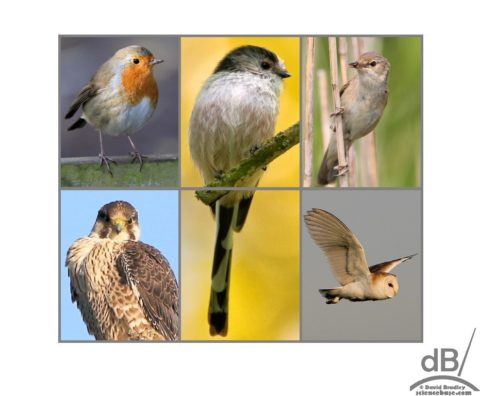
Scrollable gallery of choice snaps here: https://imagingstorm.co.uk/british-birds although you may notice I got ever so slightly better with tweaking my settings as the months went by. Earliest shots are at the bottom of the long table.
Pictured above from top left to bottom right: Robin (Erithacus rubecula), Long-tailed Tit (Aegithalos caudatus), Reed Warbler (Acrocephalus scirpaceus), Peregrine Falcon (Falco peregrinus), Barn Owl (Tyto alba).
Executive summary for moonshots with an SLR and a telephoto lens
Pick a cold, clear night, when the moon is in the sky.
Set up your camera and lens on a sturdy tripod outside. Let the kit acclimatise before shooting.
Use the longest focal length lens you have available to fill the frame with mostly moon.
Use the camera’s shutter timer or a remote shutter control.
Use LiveView or the equivalent to reduce vibration from the moving mirror.
Use a fast shutter speed, at least 1/180s.
Find your lens’ optimal small aperture, commonly sharper photos are at about f/8, but it does vary. This is about quality rather than depth of field.
Set the ISO as low as possible to reduce image noise but to allow a decent exposure. I’d say ISO 640 is the upper limit.
Shoot RAW to give you all the data to allow you to get the best image in post-processing.
Use a photo editor to crop to taste, adjust levels, boost contrast, and sharpen your photo.
If you’re sharing it on social media, make a copy of the final processed photo as a JPEG (85-90% quality) and resize it to 1024 pixelwidth, apply a touch more sharpening to that, add your logo/watermark, save, and share.
TL:DR
Use as long a zoom lens as you have access to. A sturdy and stable tripod and a remote shutter control. If you don’t have a shutter control, use timer mode and set it to 10 seconds to give the camera time to settle after your press the shutter. You need to choose a fairly still and clear night (cold and low humidity will give the best “seeing” as astronomers say. Unless you really want a full moon, go for a waxing or waning gibbous or a crescent and you’ll get those terminator craters and mountains. Also, full moon is brighter and harder to control exposure, although it definitely can be done.
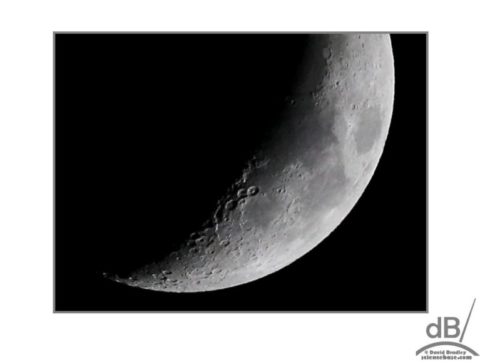
I shoot with a Sigma 15-600mm zoom on a Canon 6D (later a 7Dii). Set your ISO to around 1000 (I try to go for about 640 on the 7Dii), opt for shutter priority 1/1000s, aperture left to its own devices but f/6.3, and EV it up a few notches +0.7, say but check your exposure with each shot and adjust accordingly (I’ve not found EV was any use on the 7Dii). Opt for single-point autofocus on the craters towards the dark edge but where there is still sunlight or use Live View mode instead of your viewfinder and manually focus. I’d recommend Live View mode or the equivalen on your brand regardless.
I generally crop in quite tight and enhance contrast using curves or levels ever so slightly to make sure the black sky is black but without losing too much detail at the edge of the moon. Also a little bit of unsharp masking on luminance only doesn’t go amiss, but don’t overdo it or your moon shot will look faked. There are many more sharpening tools, such as Topaz Sharpen AI that have appeared since I wrote this article, they can give your photo a boost. Also Topaz Denoise AI.